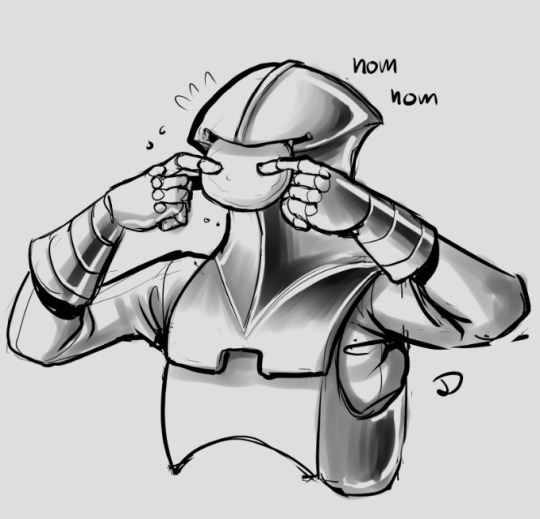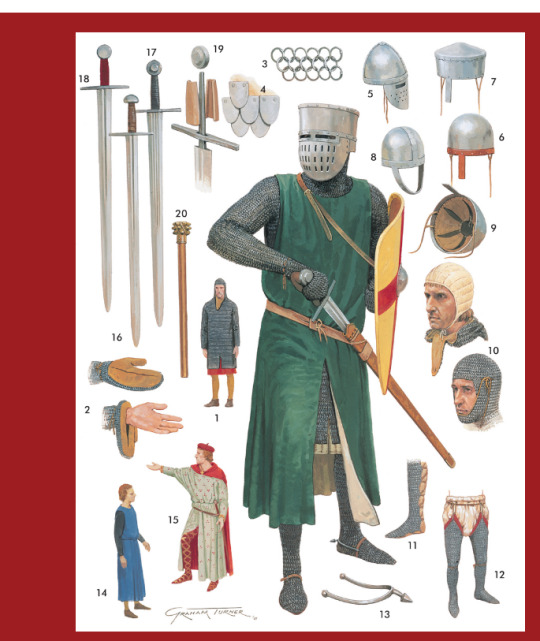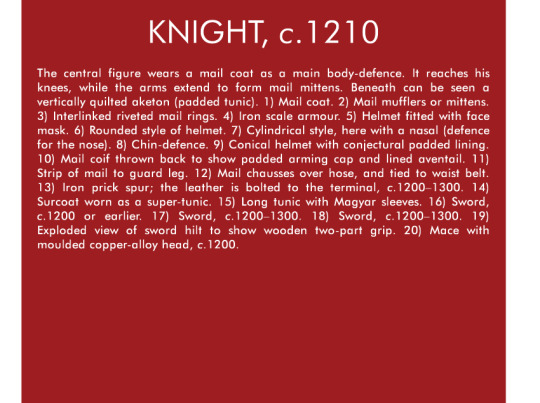Text
Maybe i should update blog...
uhh i probably should
4 notes
·
View notes
Text
This is useful for me for no particular reason...
There are many instances of repair and refurbishment. A constant battle is waged against rust as attested by numerous payments for oil and bran: by rolling mail defences in a scouring barrel the bran acts as an effective abrasive. Elbow grease was often the most effective (and cost effective) 'substance'. For every piece of plate armour referred to as 'burnished' or 'white', a man (or boy) would be required to diligently polish it to a mirror finish. Emery from Alexandria was used on Edward of Caernarfon's harness and one pound of the stuff on Henry, earl of Derby's. There are white shammies for polishing hauberks and many bespoke trunks, coffers, and bags constructed for the carriage of weapons and armour. Source: Medieval Arms and Armour, a Sourcebook, Volume 1.
8 notes
·
View notes
Text

frog-helmet knight only eats flat foods
25 notes
·
View notes
Text
Cool

I have not been normal about decorated borders on visors today
5 notes
·
View notes
Text

Source: Armour of the English Knight 1400-1450 An illustration of the lancegay. Lighter than a standard heavy cavalry lance, it would be pointed at both sides and could be used for both mounted and dismounted combat. It was favoured by the English for the rarity of their cavalry charges.
8 notes
·
View notes
Text

Source: Sir John Fastolf and the Diverse Affinities of the Medieval Lancegay (text below the cut)
Text: Apparent in the military manual published by Sir John Smythe in 1599, when the author describes the arming and training of light horsemen 'such as in diuers shires of england we doo now vse'. In Smythe's opinion, ...and instead of Launaces or speares, I woulde wish them to haue Launces commonlie called Launcezagayas of good, tite, and stiff ash, coloured black, with double heads of good and hard temper according to the vse of the Moores of 18. or 20. foot long; to the intent that taking them in the midst, they may strike both forward and backewarde, I maen aswell [sic] their enemies that they haue in frunt [sic] or in flanks....
5 notes
·
View notes
Text
Welcome to my blog
I love all things history, but especially forts. Whether it be castles, gun-forts, mottes, wooden forts, manor houses, or basically anything that is remotely fortified. I plan to post weekly (mostly on weekends) about the coolest castles i find (and maybe about the castles i visit if i visit any).

Turku Castle, Turku, Finland (I've been here its so cool!!)
Anyway i hope you enjoy my blog even if you aren't as much a history buff as i am.
4 notes
·
View notes
Text


Source: The Medieval Knight -- Christopher Gravett
(Alt text under the cut)
Text: Knight, c. 1210 The central figure wears a mail coat as a main body-defence. It reaches his knees, while the arms extend to form mail mittens. Beneath can be seen a vertically quilted aketon (padded tunic). 1) Mail coat. 2) Mail mufflers or mittens. 3) Interlinked riveted mail rings. 4) Iron scale armour. 5) Helmet fitted with face mask. 6) Rounded style of helmet. 7) Cylindrical style, here with a nasal (defence for the nose). 8) Chin-defence. 9) Conical helmet with conjectural padded lining. 10) Mail coif thrown back to show padded arming cap and lined aventail. 11) Strip of mail to guard leg. 12) Mail chausses over hose, and tied to waist belt. 13) Iron prick sur; the leather is bolted to the terminal, c.1200-1300. 14) Surcoat worn as a super-tunic. 15) Long tunic with Magyar sleeves. 16) Sword, c.1200 or earlier. 17) Sword, c.1200-1300. 18) Sword, .1200-1300. 19) Exploded view of sword hilt to show wooden two-part grip. 20) Mace with moulded copper-alloy head, c.1200
20 notes
·
View notes
Text

Nyköpingshus is one of my favorite castles. I've always wanted to go there but never really had the chance. Nyköpingshus lays along the Nyköpingsån (Nyköpings river) and was originally founded in the late 12th century as a motte, however the specifications of this tower is unknown and in the 13th century it was rebuilt into a castle. The Erikskrönika (an account of Swedish political history in the 13th century) states that future king Magnus Ladulås shall have ducal rights over all of "Sudermanland ok nyköpungs hwss" in 1266, which may be the earliest mention of the castle to date. The earliest verified record however is in 1308 when Erik Magnusson signed a bond on the castle. In Swedish history the castle is particularly well known as the place of the gruesome Nyköpings gästabud in 1317, where after a political divide, king Birger Magnusson imprisoned his brothers duke Valdemar and Erik, who later starved to death inside the castle. Subsequently the castle was stormed and largely razed by supporters of the duke.
In the 16th century, the castle was rebuilt, however suffered catastrophic damages as a result of a large fire. The castle was subsequently not rebuilt, however much of the scavenged materials were used in the reconstruction of the Stockholm palace.

Map of the castle after the reconstructions which ended at around 1611. The oldest parts of the castle are at the top near the river. The castle has a lot more history than I've been able to talk about right now, but this should have covered the basics. Have a great day everyone!
#castle#first post#new to tumblr#sweden#sverige#history#medieval#14th century#middle ages#medieval history#historical
17 notes
·
View notes